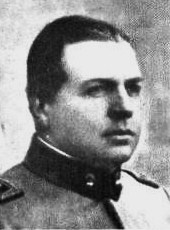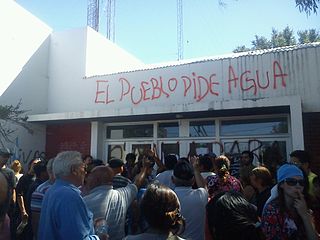
Chubut is a province in southern Argentina, situated between the 42nd parallel south, the 46th parallel south, the Andes range to the west, and the Atlantic ocean to the east. The province's name derives from the Tehuelche word chupat, meaning "transparent". their description of the Chubut River.
Neuquén is the capital city of the Argentine province of Neuquén and of the Confluencia Department, located in the east of the province. It occupies a strip of land west of the confluence of the Limay and Neuquén rivers which form the Río Negro, making it part of the ecoregion of Alto Valle del Río Negro. The city and surrounding area have a population of more than 340,000, making it the largest city in Patagonia. Along with the cities of Plottier and Cipolletti, it is part of the Neuquén – Plottier – Cipolletti conurbation.

YPF S.A. is a vertically integrated, majority state-owned Argentine energy company, engaged in oil and gas exploration and production, and the transportation, refining, and marketing of gas and petroleum products. In the 2020 Forbes Global 2000, YPF was ranked as the 1360th -largest public company in the world.

Comodoro Rivadavia, often shortened to Comodoro, is a city in the Patagonian province of Chubut in southern Argentina, located on the San Jorge Gulf, an inlet of the Atlantic Ocean, at the foot of the Chenque Hill. Comodoro Rivadavia is the most important city of the San Jorge Basin, and is the largest city in Chubut as well as the largest city south of the southern 45th parallel.
Villa Gobernador Gálvez is a city in the province of Santa Fe, Argentina, located on the western ravine of the Paraná River, within the metropolitan area of Greater Rosario. It had 74,509 inhabitants per the 2001 census [INDEC]. It is separated from Rosario, to the north, by the Saladillo Stream. It is the fourth most populated city in the province and the second in the metropolitan area.

Enrique Carlos Alberto Mosconi was an Argentine military engineer, who is best known as the pioneer and organizer of petroleum exploration and extraction in Argentina.

Caballito is a barrio (neighborhood) of the Argentine capital, Buenos Aires. It is the only barrio in the administrative division Comuna 6.

Tartagal is a tropical city in northern Argentina, in the province of Salta. It is located in the northeast of the province, within the General José de San Martín Department, of which it is the capital. It is located in the Yungas jungle, at the foot of the sub-Andean mountain ranges to the west and the Salta plains to the east. This location gives it a wide variety of flora and fauna, and its territory is home to eight indigenous communities. It stands out for the large density of large trees in its streets and squares, such as mangoes, algarrobos and lapachos. It is one of the few places in the world where the green macaw is not extinct in the wild.

Estadio Municipal de Comodoro Rivadavia (also named Estadio Km. 3 is a football stadium located in the city of Comodoro Rivadavia in the Chubut Province of Argentina. It is owned by the local Municipality and was opened in 1975. The stadium has a capacity of 8,300 spectators, and was refurbished to built press booths.

The Estadio Socios Fundadores is an indoor arena in Comodoro Rivadavia, Argentina which was opened in 1985. It is primarily used for basketball and is the home arena of Gimnasia y Esgrima de Comodoro Rivadavia. It holds 1,900 people.
Caleta Córdova is a small village with 638 inhabitants located in Escalante Department in the province of Chubut, Argentina, at the Atlantic coast 16 kilometers north of Comodoro Rivadavia, an economically oil-based city in the province of Chubut. Politically it belongs to the municipality of Comodoro Rivadavia.

The Roman Catholic Diocese of Comodoro is located in the city of Comodoro, in the Patagonian province of Chubut in southern Argentina.

In the city of Comodoro Rivadavia in the south of Argentina, we can find an important and picturesque elevation which divides the town in two, the Chenque hill. The city business district area lies at the foot of the hill. Its summit reaches 212 m above sea level and the panoramic view from the top is amazing.

The San Jorge Gulf is a bay in southern Patagonia, Argentina. It is an ocean basin opening to the Atlantic. Its shoreline spans Chubut and Santa Cruz province. The gulf measures approximately 142 miles (229 km) at its mouth and covers approximately 39 square kilometres (15 sq mi). It is located between Cape Dos Bahías and Cape Tres Puntas.

Pico Truncado is a town and municipality in Santa Cruz Province in southern Argentina. In 1921, the village's railway station was the site of one of the few open engagements between the Argentine Army and anarchist strikers at the time of the events known as Patagonia rebelde, where the army suffered its only fatality of the campaign.
Astra is a town in Chubut Province in southern Argentina and a part of the city and municipality of Comodoro Rivadavia.

Comodoro Rivadavia Cathedral is the cathedral church of Comodoro Rivadavia, Chubut Province, Argentina. It is situated at the intersection of Avenida Belgrano and Rivadavia. The cathedral is the city's main Roman Catholic church, serving the Diocese of Comodoro Rivadavia, part of the Archdiocese of Bahía Blanca. It was inaugurated by Bishop Moure Argimiro on November 26, 1978, and consecrated on June 9, 1979, by Monsignor Mariano Pérez, first Bishop of Comodoro Rivadavia. The building was constructed in Gothic-Modern style; some elements, such as a stained glass window, were brought from Turin, Italy, in 1959.

The Comodoro Rivadavia and Colonia Sarmiento Railway was an Argentine railway company that built and operated a broad gauge line that connected the port of Comodoro Rivadavia with Colonia Sarmiento in Chubut Province. The FCCRCS -belonging to Argentine State Railway- also connected to Central Chubut Railway.

Water supply problems in Caleta Olivia occurred on 2014 and culminated in a series of protests about the lack of water produced by the rupture of the aqueduct Jorge Carstens. The Sarmiento, Comodoro Rivadavia and Rada Tilly areas of Argentina were affected. The water shortage began on 10 February with a rupture near ti Cerro Dragón. This issue left the area of San Jorge Gulf without water.

The Comodoro Rivadavia rail disaster occurred on July 12, 1960, in the city of Comodoro Rivadavia in the Patagonian province of Chubut, Argentina. It happened in a region between stations Muelle YPF and Gamela in the General Mosconi neighborhood, popularly known as "Kilómetro 3".















